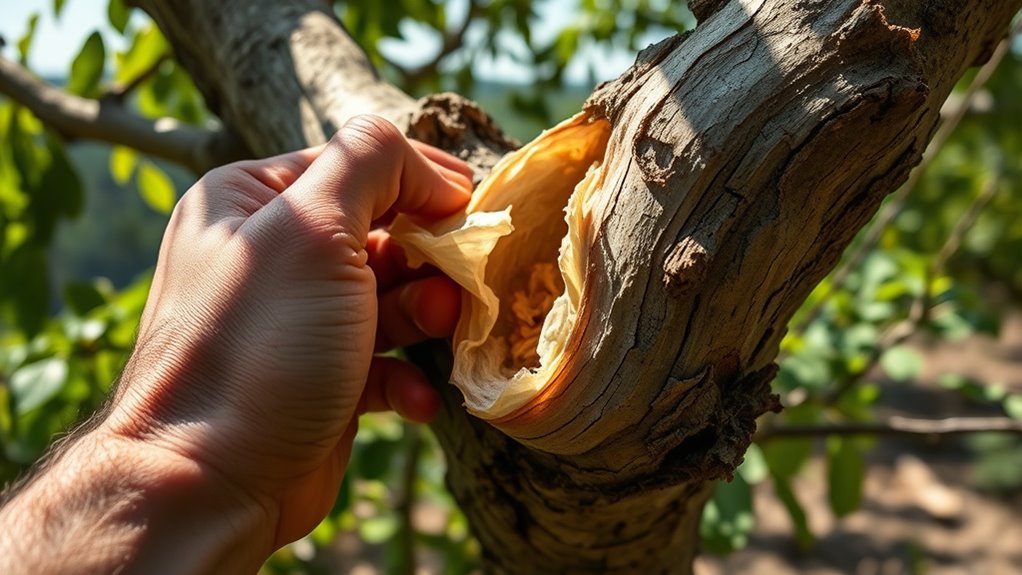Inner bark from certain trees like pine, birch, and cedar can serve as a crucial emergency food source when other supplies run out. You should carefully identify and harvest safe, sustainable bark using proper tools and techniques, ensuring the health of the tree. Preparing it by peeling, soaking, or drying makes it edible and nutritious. Staying aware of potential toxins and practicing responsible harvesting help maximize safety. Keep exploring to discover practical tips for using inner bark in survival situations.
Key Takeaways
- Identify safe, non-toxic tree species like pine, birch, or cedar for emergency bark harvesting.
- Properly peel and process inner bark by soaking, drying, or boiling to improve taste and eliminate toxins.
- Use sharp tools to harvest thin, flexible bark without damaging the tree, ensuring sustainability.
- Consume inner bark as flour, porridge, or soup base to replenish energy during shortages.
- Harvest responsibly during appropriate seasons, removing only small sections to allow tree recovery.
The Historical Use of Tree Inner Bark in Survival Situations

Throughout history, many indigenous and survival communities have relied on tree inner bark as a vital food source during times of hardship. Its historical significance is evident in various cultures that have used it for centuries, especially when other resources were scarce. These communities viewed inner bark not just as sustenance but also as part of their cultural traditions, passing down harvesting techniques and recipes through generations. For example, Arctic peoples and North American tribes incorporated bark into their diets during harsh winters and droughts. The practice reflects a deep understanding of local ecosystems and resourcefulness. By preserving these traditions, they demonstrated resilience and adaptability, ensuring survival in challenging environments. Inner bark became more than food; it symbolized survival and cultural identity. Best Beaches have historically provided communities with vital resources, similar to how inner bark served as a crucial survival food in difficult times.
Identifying Trees Suitable for Inner Bark Harvesting

You need to recognize which trees are safe for bark harvesting, focusing on native species known for edible inner bark. Pay attention to the bark’s texture and thickness, as these traits indicate where to make your cut without harming the tree. Proper identification guarantees you gather nourishment safely and sustainably. Additionally, understanding the regional variations in tree species can help you identify the most suitable options in your area.
Native Tree Species
When selecting native trees for inner bark harvesting, recognizing species with thick, fibrous bark that can be safely stripped without harming the tree is vital. Focus on trees that play a key role in local wildlife habitat, such as oaks, maples, and birches, which support diverse animal species. These trees are often part of sustainable forestry management practices, guaranteeing their health and regeneration remain intact. Avoid species that are endangered or sensitive to disturbance. By understanding which native trees are suitable, you can harvest inner bark responsibly, maintaining ecological balance. Proper identification helps prevent damage to the forest ecosystem and preserves habitat for wildlife. Additionally, understanding regulations and best practices related to foraging ensures ethical harvesting and conservation. This approach ensures you gather nourishment without compromising the forest’s long-term health.
Bark Texture & Thickness
Choosing the right trees for inner bark harvesting starts with understanding their bark’s texture and thickness. You want bark that’s smooth or slightly ridged, which indicates it’s easier to peel without damaging the tree. Thick bark can be beneficial, as it provides more usable material, but excessively thick bark may be harder to harvest. Thin bark, on the other hand, risks damaging the tree if removed improperly. Look for bark that is flexible and resilient, not brittle or overly rough. Trees with moderate bark thickness allow for easier peeling and quicker regrowth. By paying attention to bark texture and thickness, you ensure sustainable harvesting while maximizing the amount of inner bark you can harvest safely. Additionally, selecting trees with appropriate bark jack properties can facilitate easier and more efficient harvesting.
Tools and Techniques for Harvesting Inner Bark Safely

To harvest inner bark safely, selecting the right tools is essential. Proper tool selection guarantees efficient bark peeling without damaging the tree or risking injury. First, choose a sharp, sturdy knife or specialized bark peeler that allows precise cuts. Second, a small saw or pruning tool can help make clean, controlled cuts around the bark, reducing tearing. Third, carry a pair of gloves to protect your hands and a cloth or container for collecting the peeled bark. When bark peeling, use smooth, controlled motions to avoid gouging or splitting the bark deeper than necessary. Using the appropriate tools also helps prevent injury and damage, ensuring the process is safer and more sustainable for emergency nutrition. Proper tools help you work efficiently and minimize harm to the tree, making the process safer and more sustainable for emergency nutrition.
Preparing and Processing Inner Bark for Consumption

Before you can eat inner bark, you need to prepare and process it properly to guarantee it’s safe and palatable. Start with bark peeling, removing the outer bark carefully to expose the inner bark fibers. Use a sharp tool to peel in a continuous strip, avoiding damage to the tree. Once peeled, scrape away any remaining outer layers or cambium. Next, cut the inner bark into manageable pieces. To reduce bitterness and improve taste, soak the strips in water for several hours, changing the water occasionally. After soaking, you can dry the inner bark fibers by roasting or air-drying. This preparation ensures the inner bark is safe, easier to digest, and ready for consumption or further processing into flour or porridge. Utilizing proper self watering plant pots during the drying process can help maintain consistent moisture levels and prevent over-drying.
Nutritional Benefits of Tree Inner Bark

Tree inner bark is a valuable source of nutrition, especially in survival situations. It provides essential nutrients that can sustain you when traditional food sources are scarce. The bark’s nutritional content includes carbohydrates, some proteins, and minerals like calcium and magnesium, giving you crucial energy and electrolytes. However, be aware of tree bark toxins—certain species contain compounds that can be harmful if ingested in large amounts. Focusing on edible varieties enhances safety and nutritional value. Key benefits include:
- Rapid energy from complex carbohydrates
- Minerals supporting muscle and nerve function
- Trace nutrients aiding overall health
Potential Risks and How to Minimize Them

You need to be aware of potential toxins in tree inner bark and recognize warning signs of poisoning. Proper identification techniques are vital to avoid consuming harmful species, and careful preparation can reduce risks. By following safe practices, you can minimize dangers and safely use inner bark as emergency nutrition. Additionally, understanding the potential risks associated with consuming certain types of bark can help prevent adverse health effects.
Toxicity Awareness and Signs
While inner bark can be a crucial emergency food source, it’s important to recognize that it may contain toxins that can cause illness if consumed in excess or improperly prepared. Bark toxicity varies among tree species, and overconsumption can lead to poisoning symptoms such as nausea, vomiting, and diarrhea. To avoid these risks, you should:
- Identify safe tree species known for edible inner bark.
- Limit intake to small portions initially to monitor your body’s response.
- Properly process the bark by removing the outer layer and boiling it thoroughly.
- Understanding visionary quotes can inspire you to approach survival challenges with resilience and hope.
Being aware of bark toxicity is essential to prevent poisoning symptoms, which can become severe if ignored. Recognizing these signs early helps you minimize health risks and ensures safe utilization of inner bark as an emergency nutrient source.
Proper Identification Techniques
Proper identification of edible inner bark is essential to avoid consuming toxic species that can cause serious health issues. When engaging in wildlife tracking or urban foraging, look for clear signs of healthy trees, such as smooth bark, absence of fungi, and healthy leaves. Use a reliable field guide to differentiate between safe and dangerous species, paying attention to bark texture, color, and growth patterns. Avoid trees with cracks, discoloration, or signs of disease, as these may indicate toxicity. Always double-check your identification before harvesting, and if unsure, consult local foraging experts or resources. Remember, misidentifying trees can lead to severe health risks. Being precise in your identification techniques minimizes potential dangers and ensures a safe foraging experience. Incorporating AI-powered identification tools can further enhance accuracy and reduce the risk of misidentification.
Preparation and Consumption Tips
To safely consume inner bark, it’s essential to understand potential risks and how to minimize them. First, avoid harvesting from wildlife habitats or urban foraging sites that may be contaminated with pollutants or pesticides. Second, always peel away the outer bark carefully to remove any mold or bacteria that can cause illness. Third, prepare the inner bark properly by boiling or drying to eliminate parasites and reduce toxin levels. When collecting bark, use a clean, sharp tool and select healthy, non-diseased trees. Remember, overharvesting can harm trees and disrupt ecosystems, so take only what you need. Additionally, being aware of digital literacy can help you identify safe foraging practices online and avoid misinformation. By following these steps, you reduce health risks and help preserve local wildlife habitats while ensuring safe consumption.
Recipes and Methods for Incorporating Inner Bark Into Your Diet

Incorporating inner bark into your diet offers a versatile way to access emergency nutrition, and there are several simple methods to do so. Using wildcrafting techniques and accurate tree identification ensures safe harvesting. You can strip thin layers of bark, then dry and grind them into flour for baking or porridge. Another method involves boiling strips of bark to make a nourishing tea or soup base, preserving nutrients. For added flavor, you can mix bark powder into stews or smoothies. Proper tree identification is essential to avoid toxic species, and harvesting should be done carefully to protect the tree’s health. Here’s a quick guide:
| Method | Preparation | Usage Tips |
|---|---|---|
| Bark flour | Grind dried bark | Use in baking or porridge |
| Bark tea | Simmer fresh strips | Drink as a nutritious brew |
| Bark powder | Dry and grind | Mix into smoothies or stews |
| Bark strips | Boil or soak | Add to soups or broths |
Sustainable Harvesting Practices to Protect Tree Health

Because sustainable harvesting is crucial for preserving tree populations, you should always prioritize techniques that minimize damage and promote regrowth. Proper tree conservation ensures that you don’t compromise long-term health for short-term gain. To do this effectively:
- Limit inner bark removal to small, specific sections, avoiding girdling or removing more than 25% of the bark.
- Harvest during ideal seasons when trees are less vulnerable, typically late winter or early spring.
- Allow sufficient recovery time between harvests—usually several years—so the tree can regenerate its bark and maintain vitality.
Integrating Inner Bark Into Emergency Food Strategies

When emergency food sources are scarce, inner bark from certain trees offers an essential nutrient-rich option. During wildfire response, knowing how to safely harvest and incorporate inner bark can sustain you in crisis situations. It’s also valuable for urban foraging, where natural resources might be overlooked but can provide crucial sustenance. Integrating inner bark into your emergency food strategies involves identifying suitable trees—like pine, birch, or cedar—and understanding proper harvesting techniques to avoid damaging the tree. You’ll want to prioritize sustainability and safety, ensuring the bark is collected responsibly. Incorporate dried or ground inner bark into soups, stews, or energy bars for a quick, nutritious boost. Making inner bark part of your preparedness plan enhances resilience during emergencies, whether in wildlands or city environments.
Frequently Asked Questions
Can Inner Bark Be Safely Consumed by Children or Pregnant Women?
You might wonder if inner bark is safe for children or pregnant women. Generally, child safety and pregnancy considerations are vital because some tree barks contain substances that could be harmful or cause allergic reactions. While emergency situations might require consumption, it’s best to consult a healthcare professional first. Avoid regular intake without proper knowledge, as untreated bark can pose health risks, especially for vulnerable groups like children and pregnant women.
How Long Does Inner Bark Preservation Last Without Refrigeration?
Imagine a fragile seedling, needing protection to thrive. Without refrigeration, your stored inner bark’s preservation depends on effective dehydration techniques and proper storage containers. Typically, if you dry it thoroughly and keep it in airtight containers, it can last several weeks. However, exposure to humidity or air can shorten its shelf life. Always check for mold or spoilage before consumption, and prioritize airtight, cool, dry conditions for maximum longevity.
Are There Specific Signs to Distinguish Edible From Toxic Inner Bark?
When distinguishing edible from toxic inner bark, you should observe bark texture and color variation. Edible bark typically feels smooth or fibrous and has a consistent color, often lighter or greenish, while toxic bark may be rough, scaly, or have dark streaks. Always test small amounts first and look for signs of freshness, like moisture and absence of mold, to avoid poisoning. Proper identification is vital for safe consumption.
What Are the Signs of Overharvesting That Harm Tree Health?
When considering overharvesting, you should look for signs that indicate damage to the tree’s health. Sustainable harvesting involves monitoring tree health regularly, guaranteeing you don’t remove too much bark at once. Signs of overharvesting include exposed, scarred areas, reduced growth, and weakened structure. By practicing tree health monitoring and harvesting responsibly, you help preserve the tree’s vitality and ensure its resources remain available for future use.
Can Inner Bark Be Used as a Primary Emergency Food Source Long-Term?
Using tree bark as a primary emergency food source is like relying on a single thread in a tapestry—unsustainable long-term. Tree bark harvesting can damage the tree and reduce its health if overdone. While it provides some nutritional value, it shouldn’t be your main source for extended periods. Relying solely on bark risks malnutrition and environmental harm, so diversify your food sources whenever possible for balance and sustainability.
Conclusion
Remember, in survival situations, resourcefulness is your greatest asset. Harvesting inner bark can be a crucial emergency food source when done responsibly, ensuring both your safety and the tree’s health. With proper techniques, you can turn this natural resource into nourishing sustenance. As the saying goes, “Give a man a fish, and you feed him for a day; teach a man to fish, and you feed him for a lifetime.” Stay prepared and respectful of nature.










